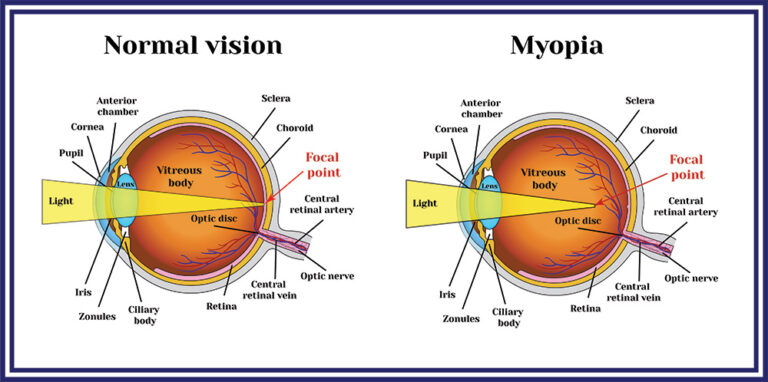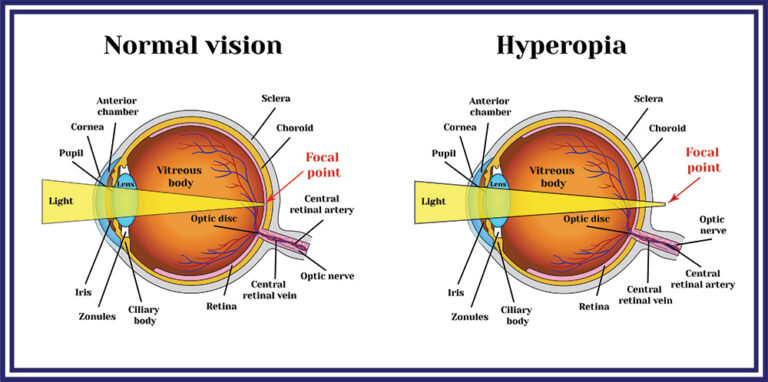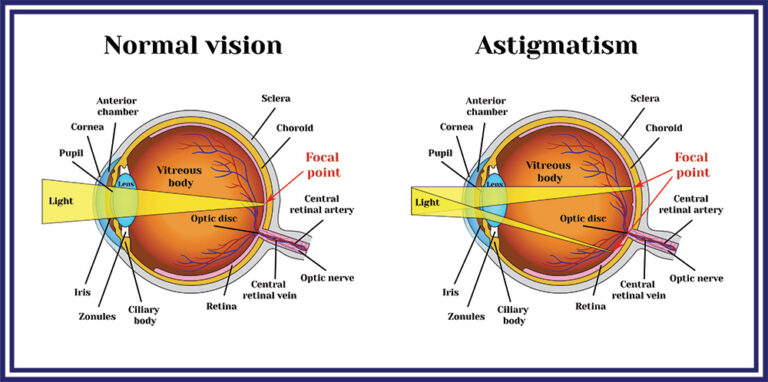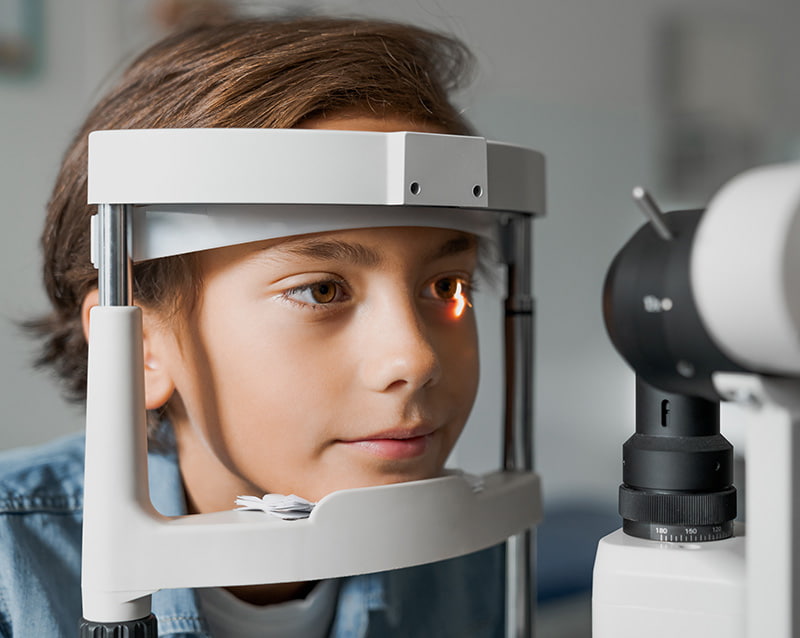Refractive Errors
Refractive errors are caused by problems in the eye that lead to blurry or distorted vision, and they often develop during childhood. It is important for children to see clearly so that they can develop and learn at a proper pace, so refractive errors in children should be treated as soon as they are diagnosed. Working with an experienced children’s eye doctor like Dr. Lucas Bonafede at Fraser Eye Care can help you safeguard the health of your child’s eyes and ensure that he or she is seeing clearly.
What is a Refractive Error?
The eye works like a camera to focus (or refract) light and produce an image. Light is focused by the cornea and crystalline lens onto the retina at the back of the eye. When light is not properly focused, or refracted, onto the retina, it is called a refractive error.1
Types of Refractive Errors
Myopia (Nearsightedness)
Myopia, or nearsightedness, is a refractive error that occurs when the cornea is too steep or the eye is longer than it should be. This causes light rays to be refracted in front of the retina, not directly on it, making distant objects appear blurry.
Myopia often runs in families, and is usually diagnosed when a child is between the ages of 8 and 12. Myopia often increases when the body is growing quickly during the teenage years, then little progression is noticed between the ages of 20 and 40.2

Hyperopia (Farsightedness)
Hyperopia, or farsightedness, is a refractive error that results when the eye is shorter than it should be or the cornea is too flat. This causes light to be refracted beyond the retina, making objects appear blurry.3
Most children are farsighted early in life, but do not have blurry vision since their eyes are able to accommodate the farsightedness. As their eyes grow, hyperopia decreases and usually disappears during adolescence. When hyperopia persists into and beyond adolescence, it is likely permanent and requires treatment with glasses.
In children under the age of 8, uncorrected moderate to severe hyperopia could lead to strabismus or amblyopia (lazy eye) and may require treatment with glasses.

Astigmatism
Astigmatism is a result of irregularities of the curvature of the cornea or lens of the eye. For example, the normal eye is spherical like a baseball, but an eye with astigmatism is shaped more like a football. This uneven curvature of the eye changes the way light rays are refracted onto the retina, leading to a refractive error.
Astigmatism can cause both near and distant vision to be blurry or distorted, but many children may not show symptoms of astigmatism. Thus, it is important to have your child’s eyes regularly examined so that any astigmatism can be properly diagnosed and treated.4

Symptoms of Refractive Errors in Children
Vision screenings are performed at yearly physicals and in schools, and can sometimes bring attention to refractive errors. However, in most cases parents notice signs of a refractive error in their child. Symptoms of a pediatric refractive error may include:
- Squinting
- Struggling with far-range tasks, like some sports
- Short attention span when engaging in up-close activities, like coloring or reading
- Headaches
- Eye pain
- Tilting the head
- Covering one eye
- Excessive rubbing of the eyes
- Sitting too close to screens5

Diagnosis of Childhood Refractive Errors
Diagnosis of refractive errors in children can be difficult, especially if a child is not yet able to speak. This is why it is important to work with an ophthalmologist who has experience working with children. Dr. Bonafede will conduct a thorough examination of the child’s eyes to determine whether his or her vision is impaired, the cause of the impairment, and the proper treatment.6
Treatment of Refractive Errors in Children
If your child has a refractive error, it is important to seek proper treatment before impaired sight affects his or her development or learning. In some cases, refractive errors that appear during childhood can lead to permanent decreased vision by the development of amblyopia (lazy eye) if not treated appropriately.
The most common treatment for pediatric refractive errors is to fit the child with eyeglasses. Even if your child already wears glasses, it is important that he or she undergo regular eye examinations to monitor the vision and ensure the glasses prescription is correct.
Contact Fraser Eye Care in Detroit
If you notice that your child may not be seeing clearly, it is important to have his or her eyes examined by an experienced pediatric ophthalmologist who can diagnose refractive errors, provide treatment, and safeguard the health of your child’s eyes. To schedule a consultation with Dr. Lucas Bonafede at Fraser Eye Care, please contact us today.
Ready to Schedule an Appointment?
Book Online Sources
Sources
1 American Association for Pediatric Ophthalmology and Strabismus. Refractive Errors in Children. Available: https://aapos.org/glossary/refractive-errors-in-children. Accessed September 8, 2021.
2 American Academy of Ophthalmology. Nearsightedness: What is Myopia? Available: https://www.aao.org/eye-health/diseases/myopia-nearsightedness. Accessed September 8, 2021.
3 American Academy of Ophthalmology. Farsightedness: Causes of Hyperopia. Available: https://www.aao.org/eye-health/diseases/hyperopia-farsightedness-causes. Accessed September 8, 2021.
4 American Academy of Ophthalmology. What is Astigmatism? Available: https://www.aao.org/eye-health/diseases/what-is-astigmatism. Accessed September 8, 2021.
5 Johns Hopkins Medicine. How to Know if Your Child Needs Glasses. Available: https://www.hopkinsmedicine.org/health/wellness-and-prevention/how-to-know-if-your-child-needs-glasses. Accessed September 8, 2021.
6 Braverman R. Diagnosis and treatment of refractive errors in the pediatric population. Curr Opin Ophthalmol. 2007 Sep;18(5):379-83. doi: 10.1097/ICU.0b013e328244dfed. PMID: 17700230. Available: https://pubmed.ncbi.nlm.nih.gov/17700230/. Accessed September 8, 2021.
Dr. Lucas Bonafede has either authored or reviewed and approved this content.

